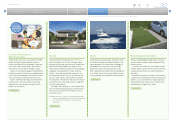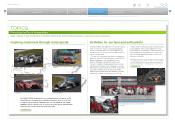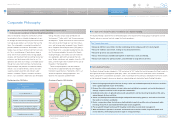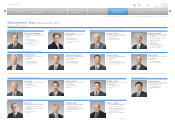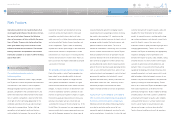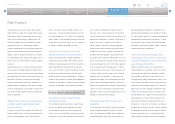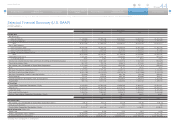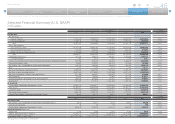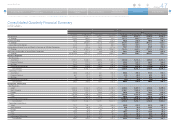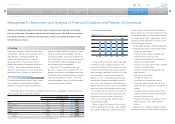Toyota 2014 Annual Report Download - page 41
Download and view the complete annual report
Please find page 41 of the 2014 Toyota annual report below. You can navigate through the pages in the report by either clicking on the pages listed below, or by using the keyword search tool below to find specific information within the annual report.
ANNUAL REPORT 2014
President’s MessagePresident’s Message
Overview of
Four Business Units
Overview of
Four Business Units
Special FeatureSpecial Feature
Review of OperationsReview of Operations
Consolidated Performance
Highlights
Consolidated Performance
Highlights
Management and
Corporate Information
Management and
Corporate Information
Investor InformationInvestor Information
Financial SectionFinancial Section
Page 41
NextPrev
ContentsSearchPrint
Risk Factors
required for innovation and development, pricing,
customer service and financing terms. Increased
competition may lead to lower vehicle unit sales,
which may result in a further downward price pressure
and adversely affect Toyota’s financial condition and
results of operations. Toyota’s ability to adequately
respond to the recent rapid changes in the automotive
market and to maintain its competitiveness will be
fundamental to its future success in existing and new
markets and to maintain its market share. There can
be no assurances that Toyota will be able to compete
successfully in the future.
The worldwide automotive industry is highly volatile.
Each of the markets in which Toyota competes has
been subject to considerable volatility in demand.
Demand for vehicles depends to a large extent on
social, political and economic conditions in a given
market and the introduction of new vehicles and tech-
nologies. As Toyota’s revenues are derived from sales
in markets worldwide, economic conditions in such
markets are particularly important to Toyota. In Japan,
the economy gradually recovered due to increasing
personal consumption and last-minute demand
spurred by the increase of the consumption tax. In the
United States, the economy has seen ongoing gradual
recovery mainly due to increasing personal consump-
tion and the European economy has shown signs of
Operational and other risks faced by Toyota that
could significantly influence the decisions of inves-
tors are set out below. However, the following
does not encompass all risks related to the opera-
tions of Toyota. There are risk factors other than
those given below. Any such risk factors could
influence the decisions of investors. The forward-
looking statements included below are based on
information available as of June 24, 2014, the filing
date of Form 20-F.
N Industry and Business Risks
The worldwide automotive market is
highly competitive.
The worldwide automotive market is highly competi-
tive. Toyota faces intense competition from automotive
manufacturers in the markets in which it operates.
Although the global economy continues to recover
gradually, competition in the automotive industry has
further intensified amidst difficult overall market condi-
tions. In addition, competition is likely to further inten-
sify in light of further continuing globalization in the
worldwide automotive industry, possibly resulting in
further industry reorganization. Factors affecting
competition include product quality and features,
safety, reliability, fuel economy, the amount of time
recovery. Meanwhile, growth in emerging markets
slowed down due to weakening currencies of emerg-
ing markets stemming from U.S. monetary easing
beginning to be curtailed, increases in interest rates of
emerging markets to protect the local currency, and
political instability in some nations. The shifts in
demand for automobiles is continuing, and it is unclear
how this situation will transition in the future. Toyota’s
financial condition and results of operations may be
adversely affected if the shifts in demand for automo-
biles continues or progresses further. Demand may
also be affected by factors directly impacting vehicle
price or the cost of purchasing and operating vehicles
such as sales and financing incentives, prices of raw
materials and parts and components, cost of fuel and
governmental regulations (including tariffs, import
regulation and other taxes). Volatility in demand may
lead to lower vehicle unit sales, which may result in
downward price pressure and adversely affect
Toyota’s financial condition and results of operations.
Toyota’s future success depends on its ability to
offer new innovative competitively priced products
that meet customer demand on a timely basis.
Meeting customer demand by introducing attractive
new vehicles and reducing the amount of time
required for product development are critical to auto-
motive manufacturers. In particular, it is critical to meet
customer demand with respect to quality, safety and
reliability. The timely introduction of new vehicle
models, at competitive prices, meeting rapidly chang-
ing customer preferences and demand is more funda-
mental to Toyota’s success than ever, as the
automotive market is rapidly transforming in light of the
changing global economy. There is no assurance,
however, that Toyota will adequately and appropriately
respond to changing customer preferences and
demand with respect to quality, safety, reliability, styling
and other features in a timely manner. Even if Toyota
succeeds in perceiving customer preferences and
demand, there is no assurance that Toyota will be
capable of developing and manufacturing new, price
competitive products in a timely manner with its avail-
able technology, intellectual property, sources of raw
materials and parts and components, and production
capacity, including cost reduction capacity. Further,
there is no assurance that Toyota will be able to imple-
ment capital expenditures at the level and times
planned by management. Toyota’s inability to develop
and offer products that meet customers’ preferences
and demand with respect to quality, safety, reliability,
styling and other features in a timely manner could
result in a lower market share and reduced sales
volumes and margins, and may adversely affect
Toyota’s financial condition and results of operations.
R&D and Intellectual Property Corporate Philosophy Corporate Governance Management Team Risk Factors [1 of 3]



